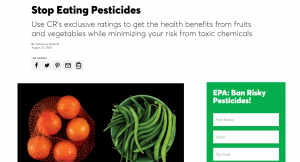Consumer Reports has taken a page out of the EGW’s playbook to create its misguided ‘Stop Eating Pesticides’ rating
Most Americans are probably familiar with Consumer Reports because they’ve consulted the organization when purchasing appliances. We’re used to seeing Consumer Reports on the local news reviewing dishwashers and toasters. It tells us what products are the best for our bottom line, and which to avoid.
Consumer Reports is actually a nonprofit that claims to fight for fairness and justice in the marketplace. Since its inception in 1936, Consumer Reports has become a trusted source for Americans looking to purchase quality products. It claims to do extensive testing and research on products in a bid to force corporations to make better products.
So why in the world am I writing about it? Because somewhere along the line Consumer Reports decided spreading fear and misinformation about agriculture fits into its agenda.
Consumer Reports has created a produce rating — under the ominous heading “Stop Eating Pesticides” — based allegedly on pesticide residues found on those products. Each item is rated Excellent, Very Good, Good, Fair, or Poor. The data isn’t new. Rather Consumer Reports simply repackaged five years’ worth of data from the USDA. But instead of evaluating the risk like the EPA does, Consumer Reports drastically decreased the tolerance amount to make it seem like those pesticide residues were scarier.
Ironically, despite the ramped standards, the vast majority of conventional produce passed with an Excellent or Very Good. But that doesn’t stop Consumer Reports from advocating that everyone purchase organic produce whenever possible, even in the face of higher prices. And, naturally, Consumer Reports relied on scientist-for-hire Charles Benbrook, the former Washington State University who’s known for publishing pro-organic junk studies.

But it gets worse: Consumer Reports is compiling a petition asking the EPA to ban the “riskiest” pesticides. It supports all these radical positions with vague statements about the harms of pesticides to human health, and all the supposed unknown risks.
Do you feel like you’ve heard this story before? That’s because you have. Consumer Reports blantantly copied the idea from the Environmental Working Group. EWG’s widely criticized — though widely publicized — “Dirty Dozen” list purports to do the exact same thing. Consumer Reports’ analysis even comes with familiar warnings about science not being accurate, pesticides creating unknowns, and the hidden danger in your grocery store.
It flies directly in the face of the USDA’s annual findings, even thought Consumer Reports used the exact same data. In 2017, USDA found that 99 percent of produce tested had pesticide residues that were well below established tolerances, meaning there’s no way you could eat enough to get sick. Better yet, 53 percent of produce had no residue at all.
Consumer Reports’ list also flies in the face of its own mission. It’s supposed to promote fairness and justice in the marketplace. So why is it urging consumers to purchase organic produce? Shoppers pay more for a marketing label that has nothing to do with nutritional improvement, quality, or value.
And we know that these types of lists actually hurt people. How? Because not everyone can afford organic produce’s higher price. Those shoppers tend to skip conventional produce, because they believe it’s somehow bad or dangerous for them. Instead they opt for more processed items that are usually higher in sodium and calories. But we all need to consume more produce!
Consumer Reports has slowly moved toward an antagonistic position of agriculture for several years now. It’s disappointing because it’s generally a well-known and trusted organization. It had an opportunity to do the right thing, and it completely failed.
Consumer Reports, stick to refrigerators. Leave agriculture alone.
Amanda Zaluckyj blogs under the name The Farmer’s Daughter USA. Her goal is to promote farmers and tackle the misinformation swirling around the U.S. food industry.



